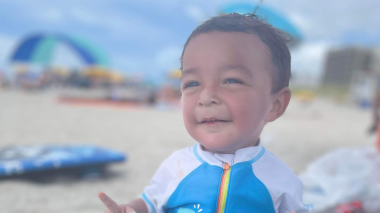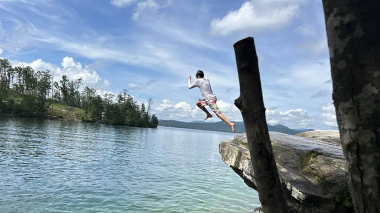For many families, warmer temperatures mean outdoor fun at summer camps, beaches, lakes and family pools.
Along with summer’s rise of water activities comes an increased risk of drowning—especially in North and South Carolina, according to Todd Vedder, MD, a pediatrician with Atrium Health Levine Children’s.
“Drowning is the leading preventable cause of death for children 1 to 4 years of age in the Carolinas,” says Dr. Vedder. “A child can die from drowning in less than one minute, so it’s critical that all members of the family understand these dangers, and learn how to prevent them from happening.”
Who’s most at risk?
While accidents occur at all ages, younger children are most at risk.
“Children ages 1 to 4 have acquired physical skills that have far outpaced their reasoning abilities, putting them at particularly high risk,” says Dr. Vedder. “Teenagers also have a heightened risk of drowning, often due to poor judgment or substance use, while children on the autism spectrum or those with seizure disorders are also particularly susceptible.”
Dr. Vedder adds that common misconceptions about drowning increase the risk of tragic incidents.
“Many people assume they would hear a splash or cry for help if their child is drowning,” says Dr. Vedder. “But drowning is actually silent. Death or permanent brain injury can happen in under a minute.”
Additionally, while the vast majority of drownings happen in pools, plenty of other water hazards exist.
“A child can drown in as little as 2 to 3 inches of water,” he says. “This increases the number of potential places a child can drown, including a shallow lake or even a bathtub.”
6 Critical Drowning Prevention Tips
Fortunately, parents and caregivers can play a key role in protecting the children they love from drowning accidents. Dr. Vedder offers parents six tips to help keep children safe this summer:
- Know before you go. Dr. Vedder encourages parents and caregivers to identify potential water safety hazards at any residence or facility where their children spend time. Whether they’ll be spending time with a relative or sitter, make sure there are multiple barriers in place to reduce the chance of your child gaining access to any water hazards. High locks and fencing are effective barriers to prevent young children from accessing pools, he says, and door alarms can help to alert adults when those perimeters have been breached. These safety precautions should also be deployed on vacations, when parents and caregivers may be preoccupied with unpacking and taking in the view — oblivious to the lack of safety barriers in an already unfamiliar terrain. To remedy this hazardous situation, Dr. Vedder recommends that parents install inexpensive adhesive door alarms upon arrival. The more barriers that are in place, he says, the lower the chance of an tragedy happening.
- Assign adult supervision. During any occasion in which children and water are involved, dedicated adult supervision is essential, stresses Dr. Vedder. Adults who are assigned to watch swimmers should avoid smartphone usage, alcohol consumption, distracting conversation and any other activities that might take their focus away from the child. Inexperienced swimmers and young children (less than 36 months old) need “touch supervision.” In other words, they should always be within arm’s length of a responsible adult.
- Enroll the family in water safety lessons. Dr. Vedder says most children are developmentally ready to begin swim lessons between 12 and 18 months of age. He adds that non-swimmers of any age, including parents who never learned to swim, should take swim lessons themselves, especially if they’ll be supervising children who are in the water.
- Skip the floaties and opt for a life jacket. “Small children, non-swimmers, boaters and jet skiers should only use U.S. Coast Guard-approved life jackets,” says Dr. Vedder. Parents should not use inflatable swimming aids such as "floaties," neck rings or other unregulated devices for their children. Examine life jackets regularly for signs of wear and tear, and replace them accordingly.
- If emergency strikes, check the pool first. “Seconds count in an emergency,” says Dr. Vedder. If a child is missing, always check the pool (or nearest water safety hazard) first. Over 60% of drowning incidents occur when the child was not expected to be near or in the pool.
- Make sure everyone is up-to-date on CPR. Cardiopulmonary resuscitation, or CPR, isn’t just for mom and dad, says Dr. Vedder. Older children, babysitters and other adults should take certified CPR classes on a regular basis. Timely intervention with proper CPR techniques can save a life.
Water Safety Resources
To learn more about water safety, Dr. Vedder recommends talking to your pediatrician as well as consulting the following authorities:
- USA Swimming Foundation (search local swim lessons)
- National Drowning Prevention Association
- Pool Safely



